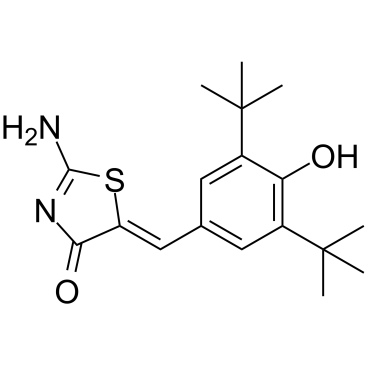139226-28-1
| Name | (5Z)-2-amino-5-[(3,5-ditert-butyl-4-hydroxyphenyl)methylidene]-1,3-thiazol-4-one |
|---|---|
| Synonyms |
4(5H)-Thiazolone, 2-amino-5-[[3,5-bis(1,1-dimethylethyl)-4-hydroxyphenyl]methylene]-, (5Z)-
cc-555 UNII-72H8H6K34C (Z)-5-(3,5-di-tert-butyl-4-hydroxybenzylidene)-2-iminothiazolidin-4-one Darbufelone [INN] (5Z)-2-AMINO-5-[(4-HYDROXY-3,5-DITERT-BUTYL-PHENYL)METHYLIDENE]-1,3-THIAZOL-4-ONE Darbufelone (5Z)-2-Amino-5-[4-hydroxy-3,5-bis(2-methyl-2-propanyl)benzylidene]-1,3-thiazol-4(5H)-one |
| Description | Darbufelone is a dual inhibitor of cellular PGF2α and LTB4 production. Darbufelone potently inhibits PGHS-2 (IC50= 0.19 μM) but is much less potent with PGHS-1 (IC50=20 μM). |
|---|---|
| Related Catalog | |
| Target |
IC50: 0.19 μM (PGHS-2), 20 μM (PGHS-1)[1] |
| In Vitro | Darbufelone is a noncompetitive inhibitor of PGHS-2 (Ki=10±5 μM). Darbufelone quenches the fluorescence of PGHS-2 at 325 nm (lambda(ex)=280 nm) with Kd=0.98±0.03 μM[1].To test the putative anti-proliferative effect of Darbufelone, A549, H520 and H460 cell lines are used, which are established from three distinct pathological subtypes of NSCLC (adenocarcinoma, squamous and large cell lung cancer respectively). Increasing concentrations of Darbufelone, ranging from 5 to 60 μM, are tested for 72 h. The cell growth inhibition of these three cell lines gradually increases with higher drug concentration. The IC50 of A549 and H520 are 20±3.6 and 21±1.8 μM, respectively, while the H460 has much lower IC50 (15±2.7 μM)[2]. |
| In Vivo | Darbufelone is a dual inhibitor of cellular PGF2R and LTB4 production. Darbufelone is orally active and nonulcerogenic in animal models of inflammation and arthritis[1]. When mice are treated with Darbufelone at dosage of 80 mg/kg/day, the tumor volumes decrease in a time-dependent manner. In contrast, lower dose of Darbufelone (20 or 40 mg/kg/day) dos not show any significant inhibition of tumor weight. At necropsy, the tumor weight in mice treated with Darbufelone (80 mg/kg/day) is reduced by 30.2% in comparison with control group[2]. |
| Kinase Assay | The effect of Darbufelone on the cyclooxygenase activity of PGHS-2 is determined in assays with no enzyme-inhibitor preincubation. HoloPGHS-2 (30 nM final concentration) is added to reaction mixtures that contain 20 mM Tris-HCl buffer (pH 7.4), 100 μM TMPD, and varying levels of Arachidonic acid (0-60 μM) and Darbufelone (0-30 μM). The cyclooxygenase activity is measured by monitoring the oxidation of TMPD at 610 nm using a microplate reader[1]. |
| Cell Assay | A549 (CCL-185, lung adenocarcinoma cancer cell line), NCI-H520 (HTB-182, lung squamous cancer cell line) and NCI-H460 (HTB-177, lung large cell cancer cell line) cells are cultured in RPMI-1640, supplemented with 10% (v/v) heat-inactivated fetal bovine serum, 2 mM L-glutamine, 100 U/mL Penicillin G, and 100μg/mL Streptomycin. Cells are grown at 37°C in a humidified atmosphere of 95% air and 5% CO2 and routinely passaged using 0.25% trypsin–EDTA. The effect of Darbufelone on human lung carcinoma cell viability is determined by MTT reduction assay. In brief, tumor cells growing in log-phase are trypsinized and seeded at 5×103 cells per well into 96-well plates and allowed to attach overnight. Medium in each well is replaced with fresh medium or medium containing various concentrations of Darbufelone (5-60 μM) in at least triplicate wells. Cells are cultured to another 72 h. After treatment, 1/10 volume of MTT solution (5 mg/mL) is added to each well, and the plate is incubated at 37°C for another 4 h. Two hundred microliters of DMSO is added to each well to solubilize the MTT-formazan product after removal of the medium. Absorbance at 595 nm is measured with a multi-well spectrophotometer. Growth inhibition is calculated as a percentage of the untreated controls[2]. |
| Animal Admin | Mice[2] C57Bl/6 male mice at 4-5 weeks are used. These mice are housed in air-conditioned quarters and are provided food and water ad libitum. On the day 0, Lewis Lung Carcinoma cells (1×106) are implanted into the left armpit of C57Bl/6 mice. The mice are randomly divided into four treatment groups of ten animals each. The day after inoculation (day 1), control group is treated with CMC-Na, and other groups are administered Darbufelone by gavage at doses of 20, 40, and 80 mg/kg/day. The treatment is continued till the end of the study. On day 14, animals are killed, and tumors are excised, weighed, and fixed in formalin for the further histochemical analysis. |
| References |
| Density | 1.2±0.1 g/cm3 |
|---|---|
| Boiling Point | 448.6ºC at 760mmHg |
| Molecular Formula | C18H24N2O2S |
| Molecular Weight | 332.460 |
| Flash Point | 225.1ºC |
| Exact Mass | 332.155853 |
| PSA | 98.48000 |
| LogP | 4.94 |
| Vapour Pressure | 1.16E-08mmHg at 25°C |
| Index of Refraction | 1.589 |
| Storage condition | -20°C |
| HS Code | 2934100090 |
|---|
| HS Code | 2934100090 |
|---|---|
| Summary | 2934100090 other compounds containing an unfused thiazole ring (whether or not hydrogenated) in the structure VAT:17.0% Tax rebate rate:9.0% Supervision conditions:none MFN tariff:6.5% General tariff:20.0% |
